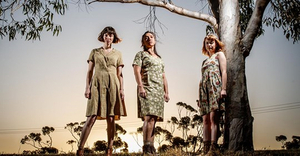 Reviewed by Ewart Shaw, Friday 11th December 2020.
Reviewed by Ewart Shaw, Friday 11th December 2020.
First, a disclaimer; in the program for this production, there is a list of donors to Theatre Republic. My name is on the list. I recognize the importance to South Australian theatre of our small companies, and the challenge that live theatre has faced this year. Corey McMahon's decision to mount this play, Angus Cerini's
The Bleeding Tree, with this impressive cast, confirms my confidence.
A murder is committed. This is not a whodunit. We know who 'dunit', and why. The play makes that explicit. This story is about what happened next, and the macabre narrative, delivered in colourful language by the three women on stage, is a robust tale of revenge. The gruesome despatch is mimed, and the gut-wrenching exploration of bodily disintegration is communicated through words.
The adjective in the title, 'bleeding' does refer to the tree from which the body is hanging, but as used in the play it's the vernacular use, it's frustration. The tree stands in the yard of an isolated and semi-derelict farmhouse. The wooden set, designed by Victoria Lamb, and built by the crew in the State Theatre Workshop, is a sounding board for three women. Elena Carapetis is the wife and mother. Her daughters Ida and Aida are Miranda Daughtrey and Annabel Matheson. That their names are so similar reinforces the symbolic nature of their existence. They are every woman in an abusive family, here dominated by a drunken truck-driving father. He is not just abusive to his family, but we learn he kicks puppies to death.
It's not just the presence of Carapetis as the mother that brings Greek tragedy and the story of Clytemnestra to mind, the queen who murdered Agamemnon out of revenge for the sacrifice of their daughter. The delivery of Cerini's text, marked by frequent rhyming passages, is choric in style, but the overwhelming influence is Macbeth. Our first sight of the three has them huddled together like the weird sisters and the final ghoulish vision is the cauldron scene.
The story takes a turn.
Mr. Jones arrives at the door. The family is terrified that he might see the badly concealed corpse. He's got the man's coat and hat from when he drove him home from the pub. He heard a shot. But he becomes complicit in the crime, as does Mrs. Smith. They both offer suggestions as to where the man might have gone, because of course, he never made it home that previous night. Evidently, his abusive behaviour was well known to a small community, happy to see the end of him, and happier still to protect his surviving family. That they bear such pedestrian names reinforces their anonymity and universality. Steven turns up. He's part-time policeman and part-time postman. There's a package to be collected. He sees the body with stomach-churning results. It's his dog who takes charge. Whose puppies were they? Guess.
Cerini relishes the graphic details of physical decay, the rats, the flies, the tumbling maggots, and the cast share that delight.
In the mix, the drab costumes from Bianca Kennedy, a soundtrack from Jason Sweeney, the design from James Oborn, and the sombre lighting of Chris Petridis, add to the atmosphere.
I didn't issue a spoiler alert. As I said at the beginning, we know who did it, and why. The short season is also, evidently, booked out. It is, however, in the telling that this brief, not quite an hour, grotesque slice of country life makes its impact.
Reader Reviews
To post a comment, you must
register and
login.
 Reviewed by Ewart Shaw, Friday 11th December 2020.
Reviewed by Ewart Shaw, Friday 11th December 2020.
